2007 HYUNDAI TUCSON child seat
[x] Cancel search: child seatPage 13 of 306
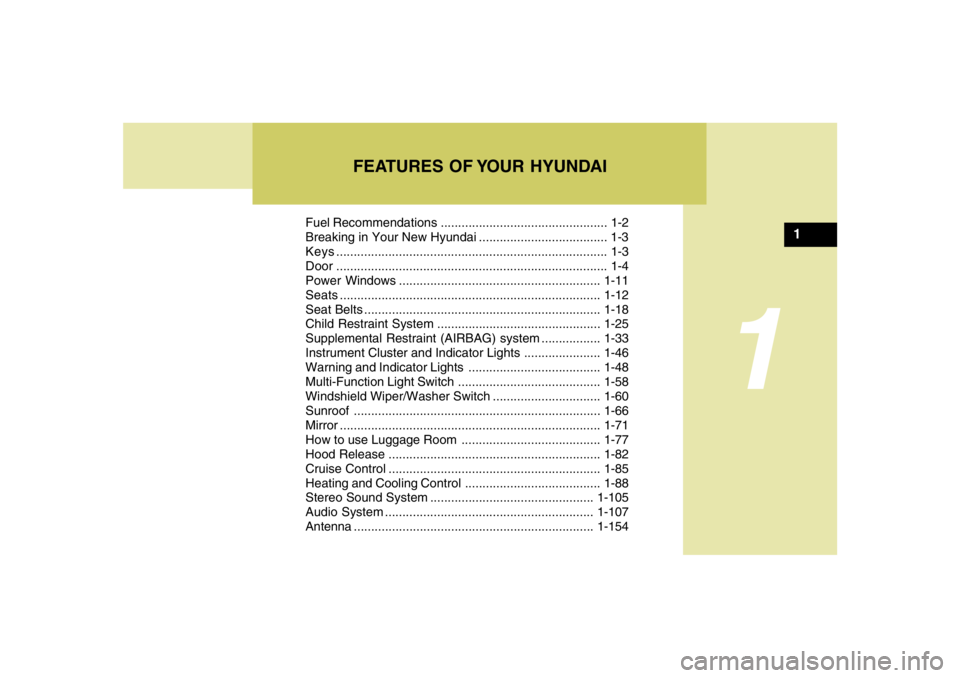
1
Fuel Recommendations ................................................ 1-2
Breaking in Your New Hyundai ..................................... 1-3
Keys.............................................................................. 1-3
Door .............................................................................. 1-4
Power Windows..........................................................1-11
Seats...........................................................................1-12
Seat Belts....................................................................1-18
Child Restraint System ...............................................1-25
Supplemental Restraint (AIRBAG) system .................1-33
Instrument Cluster and Indicator Lights...................... 1-46
Warning and Indicator Lights......................................1-48
Multi-Function Light Switch .........................................1-58
Windshield Wiper/Washer Switch...............................1-60
Sunroof.......................................................................1-66
Mirror...........................................................................1-71
How to use Luggage Room ........................................1-77
Hood Release .............................................................1-82
Cruise Control.............................................................1-85
Heating and Cooling Control .......................................1-88
Stereo Sound System...............................................1-105
Audio System............................................................1-107
Antenna.....................................................................1-154
1
FEATURES OF YOUR HYUNDAI
Page 16 of 306

1FEATURES OF YOUR HYUNDAI4
B030C01E-1
DOOR LOCKS!
B040A01A-AAT B030C01JM-AAT
ILLUMINATED IGNITION SWITCH
(If installed)Whenever either front door is opened, the igni-
tion switch will be illuminated for your conve-
nience, provided the ignition switch is not in the
"ON" position.
The light will go off approximately 10 seconds
after closing the door or when the ignition switch
is turned on.
WARNING:
o Unlocked doors can be dangerous. Be-
fore you drive away (especially if there
are children in the car), be sure that all the
doors are securely closed and locked so
that the doors cannot be opened from
the inside. This helps ensure that the
doors will not be opened accidentally.
Also, when combined with the proper
use of seat belts, locking the doors helps
keep occupants from being ejected from
the car in case of an accident.
o Before opening the door, always look for
and avoid oncoming traffic.
B030B01A-AATRecord Your Key NumberA code number is stamped on the number plate
that came with the keys to your Hyundai. This
key number plate should not be left with the keys
but kept in a safe place, not in the vehicle. The
key number should also be recorded in a place
where it can be found in an emergency.
If you need additional keys, or if you should lose
your keys, your authorized Hyundai dealer can
make new keys if you can supply the key
number.
B030B01HR
Page 19 of 306
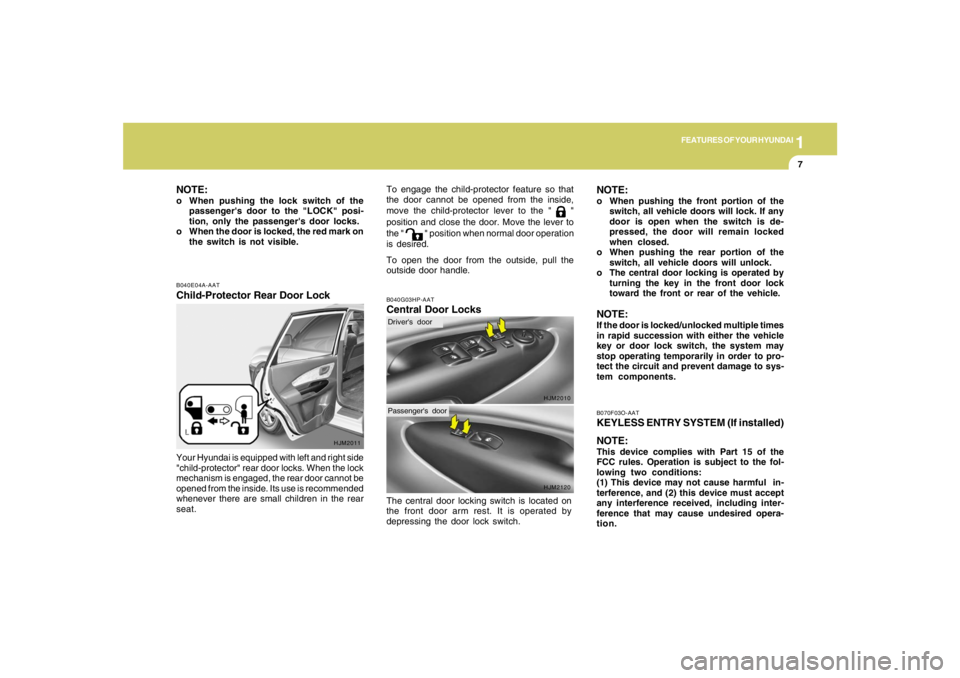
1
FEATURES OF YOUR HYUNDAI
7
B040E04A-AATChild-Protector Rear Door LockYour Hyundai is equipped with left and right side
"child-protector" rear door locks. When the lock
mechanism is engaged, the rear door cannot be
opened from the inside. Its use is recommended
whenever there are small children in the rear
seat.
HJM2011
B040G03HP-AATCentral Door LocksThe central door locking switch is located on
the front door arm rest. It is operated by
depressing the door lock switch.
HJM2010
NOTE:o When pushing the lock switch of the
passenger's door to the "LOCK" posi-
tion, only the passenger's door locks.
o When the door is locked, the red mark on
the switch is not visible.To engage the child-protector feature so that
the door cannot be opened from the inside,
move the child-protector lever to the "
"
position and close the door. Move the lever to
the "
" position when normal door operation
is desired.
To open the door from the outside, pull the
outside door handle.
NOTE:o When pushing the front portion of the
switch, all vehicle doors will lock. If any
door is open when the switch is de-
pressed, the door will remain locked
when closed.
o When pushing the rear portion of the
switch, all vehicle doors will unlock.
o The central door locking is operated by
turning the key in the front door lock
toward the front or rear of the vehicle.NOTE:If the door is locked/unlocked multiple times
in rapid succession with either the vehicle
key or door lock switch, the system may
stop operating temporarily in order to pro-
tect the circuit and prevent damage to sys-
tem components.B070F03O-AATKEYLESS ENTRY SYSTEM (If installed)
NOTE:This device complies with Part 15 of the
FCC rules. Operation is subject to the fol-
lowing two conditions:
(1) This device may not cause harmful in-
terference, and (2) this device must accept
any interference received, including inter-
ference that may cause undesired opera-
tion.
HJM2120
Driver's doorPassenger's door
Page 30 of 306
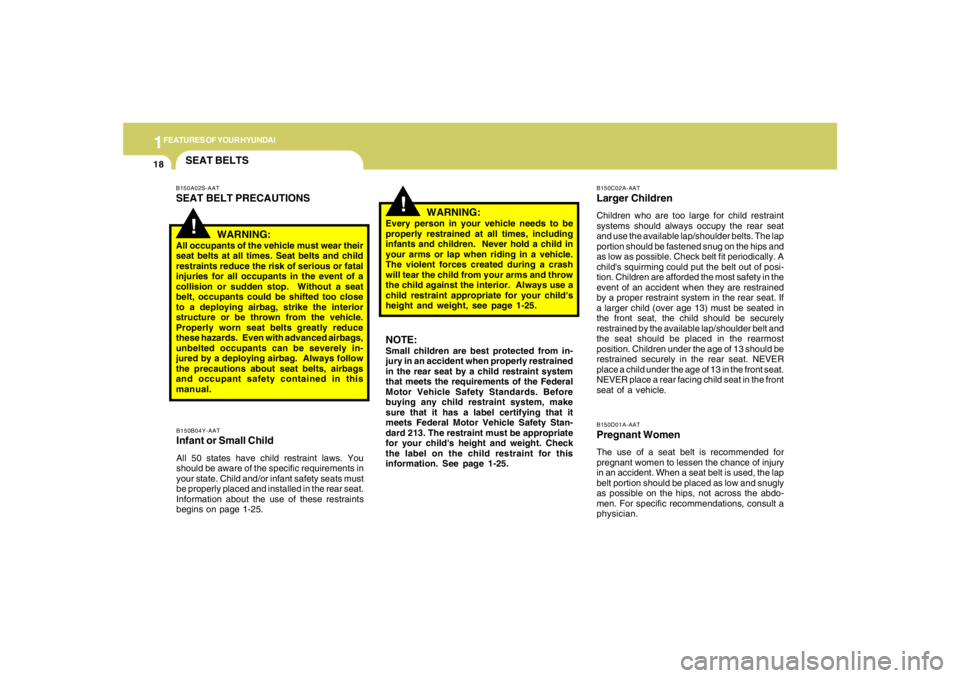
1FEATURES OF YOUR HYUNDAI18
B150C02A-AATLarger ChildrenChildren who are too large for child restraint
systems should always occupy the rear seat
and use the available lap/shoulder belts. The lap
portion should be fastened snug on the hips and
as low as possible. Check belt fit periodically. A
child's squirming could put the belt out of posi-
tion. Children are afforded the most safety in the
event of an accident when they are restrained
by a proper restraint system in the rear seat. If
a larger child (over age 13) must be seated in
the front seat, the child should be securely
restrained by the available lap/shoulder belt and
the seat should be placed in the rearmost
position. Children under the age of 13 should be
restrained securely in the rear seat. NEVER
place a child under the age of 13 in the front seat.
NEVER place a rear facing child seat in the front
seat of a vehicle.B150D01A-AATPregnant WomenThe use of a seat belt is recommended for
pregnant women to lessen the chance of injury
in an accident. When a seat belt is used, the lap
belt portion should be placed as low and snugly
as possible on the hips, not across the abdo-
men. For specific recommendations, consult a
physician.
SEAT BELTSB150B04Y-AATInfant or Small ChildAll 50 states have child restraint laws. You
should be aware of the specific requirements in
your state. Child and/or infant safety seats must
be properly placed and installed in the rear seat.
Information about the use of these restraints
begins on page 1-25.
!
B150A02S-AATSEAT BELT PRECAUTIONS
WARNING:All occupants of the vehicle must wear their
seat belts at all times. Seat belts and child
restraints reduce the risk of serious or fatal
injuries for all occupants in the event of a
collision or sudden stop. Without a seat
belt, occupants could be shifted too close
to a deploying airbag, strike the interior
structure or be thrown from the vehicle.
Properly worn seat belts greatly reduce
these hazards. Even with advanced airbags,
unbelted occupants can be severely in-
jured by a deploying airbag. Always follow
the precautions about seat belts, airbags
and occupant safety contained in this
manual.
!
WARNING:
Every person in your vehicle needs to be
properly restrained at all times, including
infants and children. Never hold a child in
your arms or lap when riding in a vehicle.
The violent forces created during a crash
will tear the child from your arms and throw
the child against the interior. Always use a
child restraint appropriate for your child's
height and weight, see page 1-25.NOTE:Small children are best protected from in-
jury in an accident when properly restrained
in the rear seat by a child restraint system
that meets the requirements of the Federal
Motor Vehicle Safety Standards. Before
buying any child restraint system, make
sure that it has a label certifying that it
meets Federal Motor Vehicle Safety Stan-
dard 213. The restraint must be appropriate
for your child's height and weight. Check
the label on the child restraint for this
information. See page 1-25.
Page 31 of 306
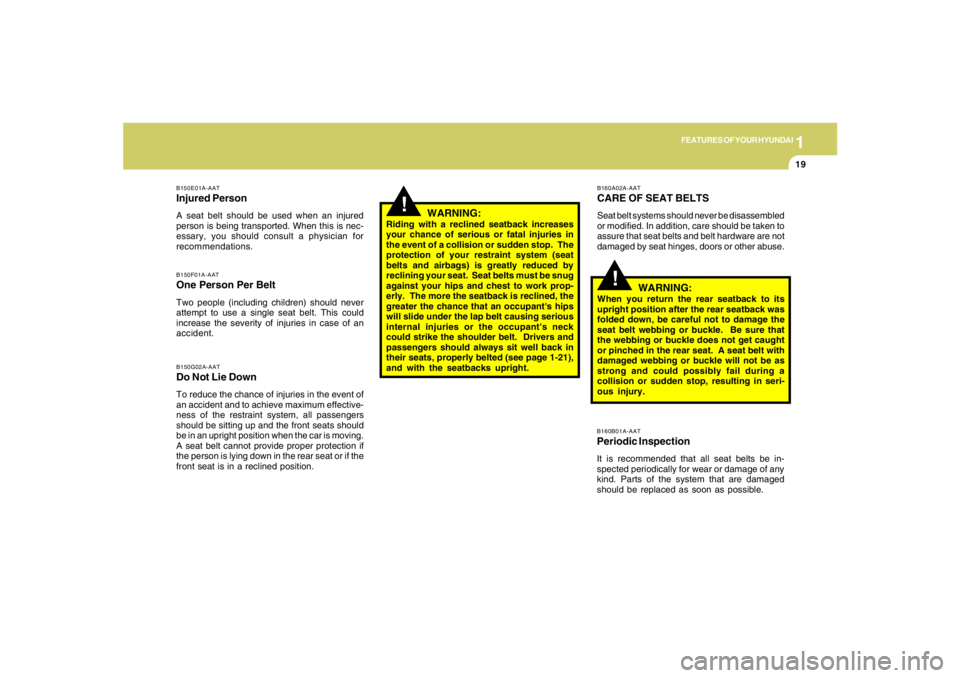
1
FEATURES OF YOUR HYUNDAI
19
WARNING:
Riding with a reclined seatback increases
your chance of serious or fatal injuries in
the event of a collision or sudden stop. The
protection of your restraint system (seat
belts and airbags) is greatly reduced by
reclining your seat. Seat belts must be snug
against your hips and chest to work prop-
erly. The more the seatback is reclined, the
greater the chance that an occupant's hips
will slide under the lap belt causing serious
internal injuries or the occupant's neck
could strike the shoulder belt. Drivers and
passengers should always sit well back in
their seats, properly belted (see page 1-21),
and with the seatbacks upright.
!
B150E01A-AATInjured PersonA seat belt should be used when an injured
person is being transported. When this is nec-
essary, you should consult a physician for
recommendations.B150F01A-AATOne Person Per BeltTwo people (including children) should never
attempt to use a single seat belt. This could
increase the severity of injuries in case of an
accident.B150G02A-AATDo Not Lie DownTo reduce the chance of injuries in the event of
an accident and to achieve maximum effective-
ness of the restraint system, all passengers
should be sitting up and the front seats should
be in an upright position when the car is moving.
A seat belt cannot provide proper protection if
the person is lying down in the rear seat or if the
front seat is in a reclined position.
!
B160A02A-AATCARE OF SEAT BELTSSeat belt systems should never be disassembled
or modified. In addition, care should be taken to
assure that seat belts and belt hardware are not
damaged by seat hinges, doors or other abuse.
WARNING:
When you return the rear seatback to its
upright position after the rear seatback was
folded down, be careful not to damage the
seat belt webbing or buckle. Be sure that
the webbing or buckle does not get caught
or pinched in the rear seat. A seat belt with
damaged webbing or buckle will not be as
strong and could possibly fail during a
collision or sudden stop, resulting in seri-
ous injury.B160B01A-AATPeriodic InspectionIt is recommended that all seat belts be in-
spected periodically for wear or damage of any
kind. Parts of the system that are damaged
should be replaced as soon as possible.
Page 33 of 306
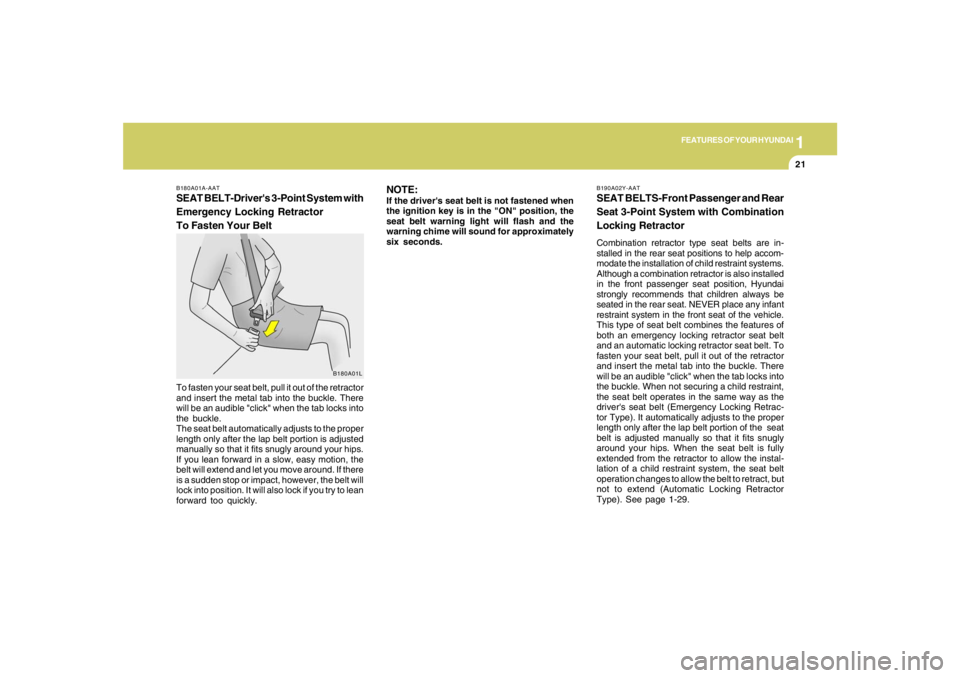
1
FEATURES OF YOUR HYUNDAI
21
B190A02Y-AATSEAT BELTS-Front Passenger and Rear
Seat 3-Point System with Combination
Locking RetractorCombination retractor type seat belts are in-
stalled in the rear seat positions to help accom-
modate the installation of child restraint systems.
Although a combination retractor is also installed
in the front passenger seat position, Hyundai
strongly recommends that children always be
seated in the rear seat. NEVER place any infant
restraint system in the front seat of the vehicle.
This type of seat belt combines the features of
both an emergency locking retractor seat belt
and an automatic locking retractor seat belt. To
fasten your seat belt, pull it out of the retractor
and insert the metal tab into the buckle. There
will be an audible "click" when the tab locks into
the buckle. When not securing a child restraint,
the seat belt operates in the same way as the
driver's seat belt (Emergency Locking Retrac-
tor Type). It automatically adjusts to the proper
length only after the lap belt portion of the seat
belt is adjusted manually so that it fits snugly
around your hips. When the seat belt is fully
extended from the retractor to allow the instal-
lation of a child restraint system, the seat belt
operation changes to allow the belt to retract, but
not to extend (Automatic Locking Retractor
Type). See page 1-29. To fasten your seat belt, pull it out of the retractor
and insert the metal tab into the buckle. There
will be an audible "click" when the tab locks into
the buckle.
The seat belt automatically adjusts to the proper
length only after the lap belt portion is adjusted
manually so that it fits snugly around your hips.
If you lean forward in a slow, easy motion, the
belt will extend and let you move around. If there
is a sudden stop or impact, however, the belt will
lock into position. It will also lock if you try to lean
forward too quickly.
B180A01A-AATSEAT BELT-Driver's 3-Point System with
Emergency Locking Retractor
To Fasten Your Belt
B180A01L
NOTE:If the driver's seat belt is not fastened when
the ignition key is in the "ON" position, the
seat belt warning light will flash and the
warning chime will sound for approximately
six seconds.
Page 34 of 306
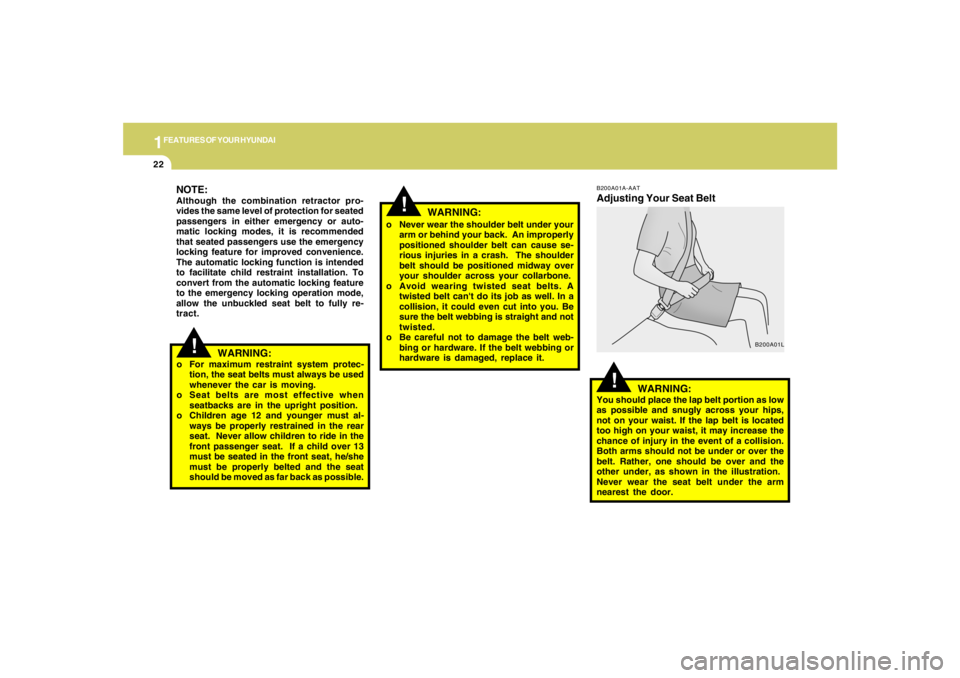
1FEATURES OF YOUR HYUNDAI22
!
NOTE:Although the combination retractor pro-
vides the same level of protection for seated
passengers in either emergency or auto-
matic locking modes, it is recommended
that seated passengers use the emergency
locking feature for improved convenience.
The automatic locking function is intended
to facilitate child restraint installation. To
convert from the automatic locking feature
to the emergency locking operation mode,
allow the unbuckled seat belt to fully re-
tract.
WARNING:
o For maximum restraint system protec-
tion, the seat belts must always be used
whenever the car is moving.
o Seat belts are most effective when
seatbacks are in the upright position.
o Children age 12 and younger must al-
ways be properly restrained in the rear
seat. Never allow children to ride in the
front passenger seat. If a child over 13
must be seated in the front seat, he/she
must be properly belted and the seat
should be moved as far back as possible.
o Never wear the shoulder belt under your
arm or behind your back. An improperly
positioned shoulder belt can cause se-
rious injuries in a crash. The shoulder
belt should be positioned midway over
your shoulder across your collarbone.
o Avoid wearing twisted seat belts. A
twisted belt can't do its job as well. In a
collision, it could even cut into you. Be
sure the belt webbing is straight and not
twisted.
o Be careful not to damage the belt web-
bing or hardware. If the belt webbing or
hardware is damaged, replace it.
!
WARNING:
You should place the lap belt portion as low
as possible and snugly across your hips,
not on your waist. If the lap belt is located
too high on your waist, it may increase the
chance of injury in the event of a collision.
Both arms should not be under or over the
belt. Rather, one should be over and the
other under, as shown in the illustration.
Never wear the seat belt under the arm
nearest the door.
!
B200A01A-AATAdjusting Your Seat Belt
B200A01L
WARNING:
Page 37 of 306
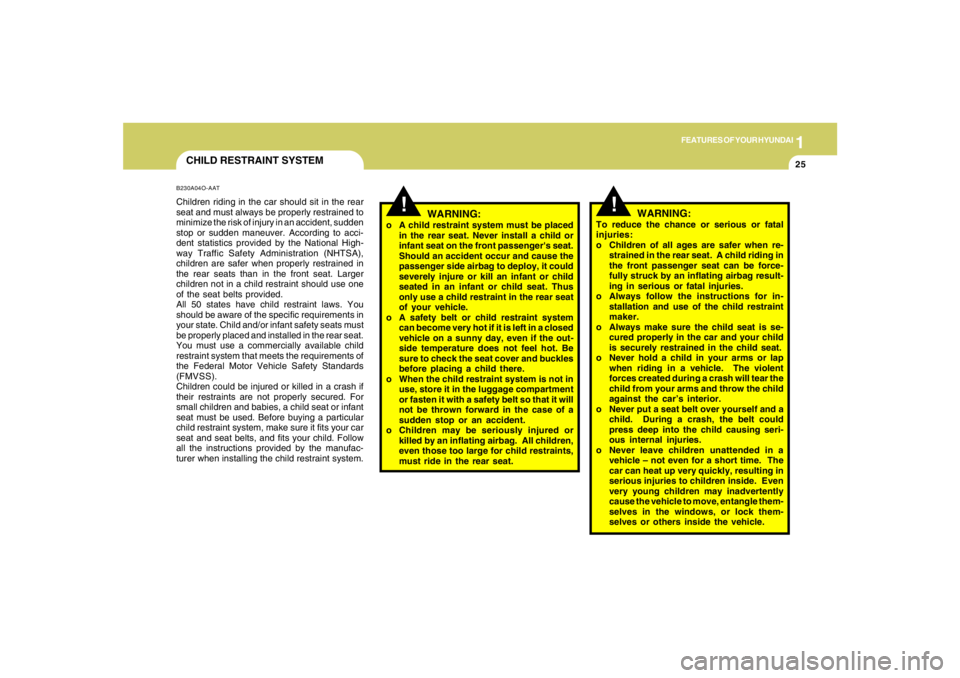
1
FEATURES OF YOUR HYUNDAI
25
CHILD RESTRAINT SYSTEMB230A04O-AATChildren riding in the car should sit in the rear
seat and must always be properly restrained to
minimize the risk of injury in an accident, sudden
stop or sudden maneuver. According to acci-
dent statistics provided by the National High-
way Traffic Safety Administration (NHTSA),
children are safer when properly restrained in
the rear seats than in the front seat. Larger
children not in a child restraint should use one
of the seat belts provided.
All 50 states have child restraint laws. You
should be aware of the specific requirements in
your state. Child and/or infant safety seats must
be properly placed and installed in the rear seat.
You must use a commercially available child
restraint system that meets the requirements of
the Federal Motor Vehicle Safety Standards
(FMVSS).
Children could be injured or killed in a crash if
their restraints are not properly secured. For
small children and babies, a child seat or infant
seat must be used. Before buying a particular
child restraint system, make sure it fits your car
seat and seat belts, and fits your child. Follow
all the instructions provided by the manufac-
turer when installing the child restraint system.
WARNING:
To reduce the chance or serious or fatal
injuries:
o Children of all ages are safer when re-
strained in the rear seat. A child riding in
the front passenger seat can be force-
fully struck by an inflating airbag result-
ing in serious or fatal injuries.
o Always follow the instructions for in-
stallation and use of the child restraint
maker.
o Always make sure the child seat is se-
cured properly in the car and your child
is securely restrained in the child seat.
o Never hold a child in your arms or lap
when riding in a vehicle. The violent
forces created during a crash will tear the
child from your arms and throw the child
against the car’s interior.
o Never put a seat belt over yourself and a
child. During a crash, the belt could
press deep into the child causing seri-
ous internal injuries.
o Never leave children unattended in a
vehicle – not even for a short time. The
car can heat up very quickly, resulting in
serious injuries to children inside. Even
very young children may inadvertently
cause the vehicle to move, entangle them-
selves in the windows, or lock them-
selves or others inside the vehicle.
!
!
WARNING:
o A child restraint system must be placed
in the rear seat. Never install a child or
infant seat on the front passenger's seat.
Should an accident occur and cause the
passenger side airbag to deploy, it could
severely injure or kill an infant or child
seated in an infant or child seat. Thus
only use a child restraint in the rear seat
of your vehicle.
o A safety belt or child restraint system
can become very hot if it is left in a closed
vehicle on a sunny day, even if the out-
side temperature does not feel hot. Be
sure to check the seat cover and buckles
before placing a child there.
o When the child restraint system is not in
use, store it in the luggage compartment
or fasten it with a safety belt so that it will
not be thrown forward in the case of a
sudden stop or an accident.
o Children may be seriously injured or
killed by an inflating airbag. All children,
even those too large for child restraints,
must ride in the rear seat.